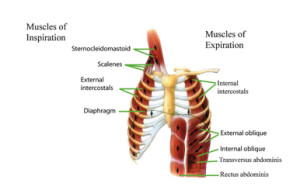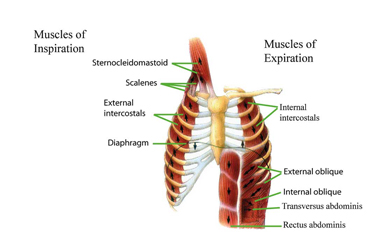My first introduction to healthy, yogic breathing came from my beloved mentor Jamie. As Jamie’s counseling apprentice, I co-taught a college stress management class. Clearly I had survived into my 20s so I must have been taking the oxygen in, and releasing the carbon dioxide out. But learning how to breathe in a conscious, relaxing, yogic way was a revelation.
Reverse Breathing Revealed-How are you breathing?
Through working individually and in class with Jamie, I realized that I was reverse breathing: on the inhale my belly would recede, and on the exhale it would puff out.
It took me countless hours of practice to unlearn this stress producing habit. Unfortunately, many students in my classes had picked up the same pattern, so I could clearly empathize with their struggles.
For much of the populace, the awareness of the expansion in all directions of the abdomen on the inhale can be a revolutionary, quality-of-life changing event. Aren’t we taught to suck it up, hold it in, and flatten it out?
Yogic Breathing
Pranayama is the Sanskrit term for the practice of yogic breathing. Pranayama literally means “extension of the life force”. The yogis have perfected scores of techniques to consciously recruit the breath to calm us, heat us, cool us, and tone our respiratory musculature.
Learning to harness the powers of our breath in all kinds of situations is a key to health of the body/mind.
Introduction to your Intercostals-Side body/breath consciousness
The intercostals are an integral and much overlooked part of a full bodied breath.
There are several muscle groups associated with our miraculous breath, the primary muscle is of course the dome like thoracic diaphragm. This is a nice drawing of the diaphragm and the intercostals.
The intercostals (intercostal=between the ribs), work in tandem with the diaphragm; the diaphragm is responsible for approximately 70% and intercostals 30% of moving the our breath.
The intercostal muscles form two thin layers that span each of the intercostal spaces. The external intercostals are oriented obliquely downward, the same direction as if you were putting your hands in your front jeans pockets. They assist the diaphragm with the inhale. You can feel the ribs draw up as you take in air.
The internal intercostals are situated similarly to your back jeans pockets. They run posteriorly and downward and are mostly associated with the exhale.
Practice this:
Standing or sitting with good posture, place your hands on either side of your ribs, as if you are a disgruntled parent waiting for their to teen arrive home past curfew. Very gently place your fingers between the spaces of the ribs.
Now begin long, slow, and deep yogic complete breaths.
Can you feel the lateral expansion of the ribs on the inhale? Can you feel the contraction on the exhale? That is the coordinated result of the diaphragm and intercostals working together. As you feel comfortable with intercostal 3D breath, you will eventually be able to direct your breath into the pelvic muscles.
A version of this article was originally published on Yoga Tune Up.


4 Comments
Having read all of the current articles on Bonnie’s blog I felt the need to confess when I finished reading this one. I find myself holding my breath when doing any pose that takes some concentration. If Bonnie were not frequently reminding the class to breath I would likely pass out. This is something that I am working on outside of yoga class as well. I must also mention that I really appreciate the fact that Bonnie not only teaches us the many benefits of yoga but also shows the class the anatomical effects different poses have on our bodies. Thank you Bonnie for being so thorough in your teachings and guiding us slowly and giving us constant encouragement! Namaste
It is a pleasure to have you in class Lisa1
Before my yoga practice began, I was a shallow breather. One of my phobias in life is not being able to take a deep breath, or to lose my breath (hope I never get the wind knocked out of me!) Right from the beginning, Bonnie impressed upon my class the importance of breathing and instructed us on the Complete Yoga Breath. It took me a good four or five classes before I could get my mind and body to accept this proper way air intake. I found myself holding my breath during twisted triangles, half moons, and so on! I thank God that Bonnie was there to remind me to BREATHE! When I finally got my mind and body to accept this new breathing practice, it was glorious! I was so amazed at how much better I felt, inside and out…and still do. Bonnie took great care in explaining, in detail, what breathing properly does for the body. Complete Yoga Breath is part of my daily practice now…with necessity! I catch myself from time to time falling back into my shallow breathing, when my mind is too full and in stressful times; I call this my “disconnection”. I am still learning to connect to my breath every moment of every day (isn’t this a life-long process?) and I recognize that I must love my body so that it loves me back…and for me it all starts with BREATHING! Thank you Bonnie…you are such a blessing!
You are a wonderful Yogini Glenda. Thank you for your kind words!
Comments are closed.